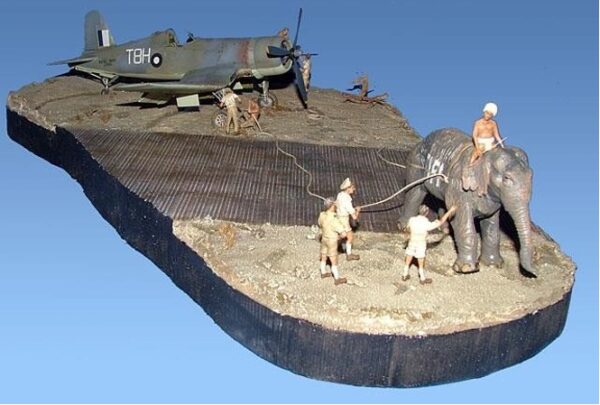HMS Rajaliya and ‘The Puttalam Elephants’ –by Roger Thiedeman
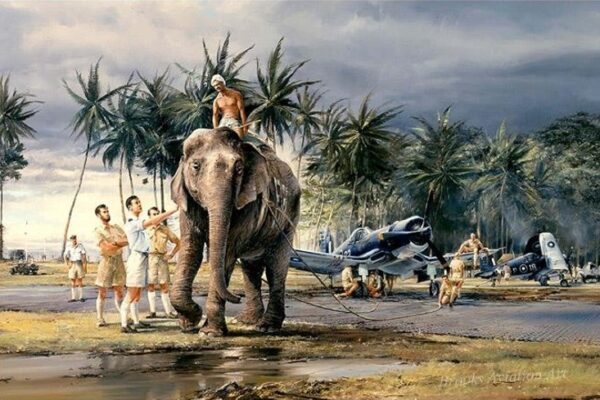
In the Sunday Times of February 2, 1997, in an article titled ‘Of aeroplanes and jumbos’, I told about ‘The Puttalam Elephants’, a painting by renowned aviation artist Robert Taylor. The painting was based on actual, wartime events in Ceylon at the Puttalam-Palavi airbase of the Royal Navy’s Fleet Air Arm, where elephants were used to haul the squadron’s Vought F4U Corsair fighter ‘planes onto firmer ground whenever they became bogged in mud after monsoonal rain.
Robert Taylor ‘constructed’ his painting solely on the strength of a few notes and a rough sketch of the airfield given to him by Commander Sam McDonald-Hall, one of the British officers who had flown Fleet Air Arm Corsairs at Puttalam. In his notes to Taylor, McDonald-Hall had typed the name of the shore station as ‘H.M.S. Rigolia’.
At the time of my writing, in a place far from Sri Lanka and with the Internet still in its infancy, I had barely scratched the surface with my research into Ceylonese/Sri Lankan aviation history, not least the wartime side of things. Not knowing any different, I blindly repeated that station name in my Sunday Times piece. Furthermore, Sam McDonald-Hall had also spelt Puttalam as ‘Puttleham’
– which itself should have alerted me to the probability that ‘Rigolia’ too was incorrect.
Not long afterward, though, I discovered by chance that the Fleet Air Arm base at Puttalam was not called ‘Rigolia’ but HMS Rajaliya (Sinhala for ‘eagle’). I promptly submitted a follow-up item to the Sunday Times, correcting my ‘ignorant’ mistake and apologising to readers for any confusion I may have caused.
The error became apparent when someone gave me two photographs, with detailed captions, taken at HMS Rajaliya, Puttalam during the closing stages of World War II. The photos are reproduced below with their original captions.
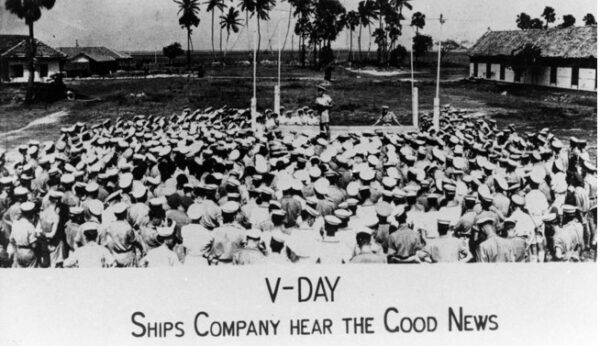
“Royal Naval Air Station, Puttalam, Ceylon (HMS ‘Rajaliya’). Ship’s company
hear news that war in Europe has ended. 8 May 1945” [VE Day].
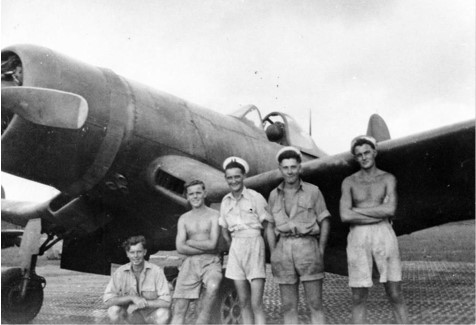
“Looking at photo, Wilkins 5th from left [or extreme right?]. Royal Naval Air Station, Puttalam, Ceylon (HMS ‘Rajaliya’). No. 1 Corsair Squadron, Naval Operational Training Unit, South East Asia Command (SEAC).
Corsair aircraft, 1944.”
News of the war’s end in Europe (although the fight against Japan wouldn’t conclude for another three months) was probably joyously received by the famed Puttalam elephants too, knowing they could soon return to more ‘elephantine’ tasks instead of extricating those noisy, smelly flying machines from the mud!
Here, now, is my original Sunday Times article in revised form, with the correct rendition ‘Rajaliya’ replacing the erroneous and meaningless ‘Rigolia’.
*****
Of aeroplanes and jumbos
Robert Taylor is a British artist who specialises in aviation and maritime paintings. Over a celebrated career spanning many years he has garnered a well- deserved reputation for his amazingly accurate, attention-to-detail depictions of aerial and naval scenes and battles, which command substantial prices the world over.
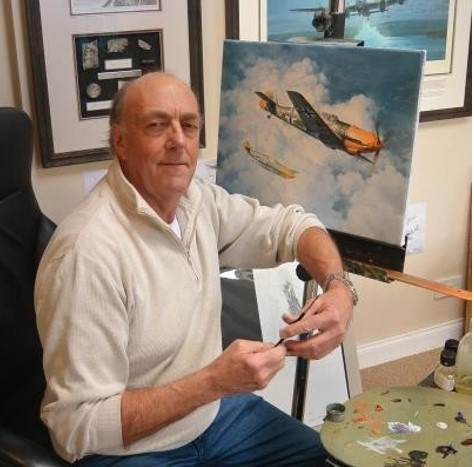
Aviation and naval artist Robert Taylor (in younger days)
One of Taylor’s more notable paintings now hangs in the museum of the Fleet Air Arm at Yeovilton, England. Titled ‘The Puttalam Elephants’, it has special significance for Sri Lankan aviation enthusiasts. The painting depicts an unusual aspect of ground operations at the Royal Navy shore-based fighter aircraft station HMS Rajaliya which was located at Puttalam airfield, Ceylon during World War II.
The squadron was equipped with US-built Vought F4U Corsair Mk. IV airplanes. A beautiful aircraft, the Corsair had a distinctive ‘gull-wing’ look, most apparent when viewed from the front.
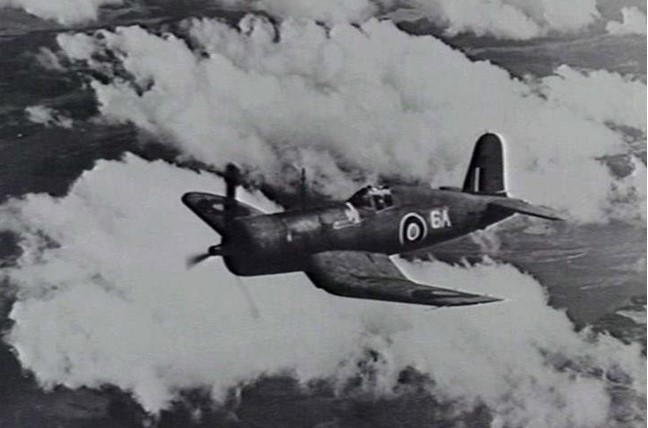
Vought F4U Corsair Mk. I of the Royal Navy’s Fleet Air Arm
(photo: © Australian War Memorial)
Regarded by the Japanese as the most formidable American fighter of the Second World War, it was a powerful machine that often proved a handful for pilots, no matter how skilled they were. On the ground, or close to it when about to touch down, visibility from the cockpit was not ideal, and the aircraft had a nasty tendency to bounce violently on landing.
As if the Corsair and its handling idiosyncrasies were not enough, the Puttalam airfield posed additional problems for pilots of HMS Rajaliya. The area was surrounded by dense jungle on three sides, while the runway end closest to the not-too-distant coast was hemmed in by coconut trees. When the military took over the Palavi site they sought to strengthen the soft grass landing strip by laying down large, perforated steel mesh plates known as Pierced Steel Planking (PSP), or Sommerfeld Tracking (named after German inventor Kurt Sommerfeld).
While the PSP enabled heavier aircraft to land at Puttalam with relative ease, the steel surface became slippery when it rained, which, during the monsoon period, was often. So when a Corsair touched down in such conditions, its tricky landing characteristics conspired with the wet PSP to send the aircraft slithering off into the sandy surrounds, now turned into a quagmire by the rain. The result? A Corsair with its wheels bogged in mud.
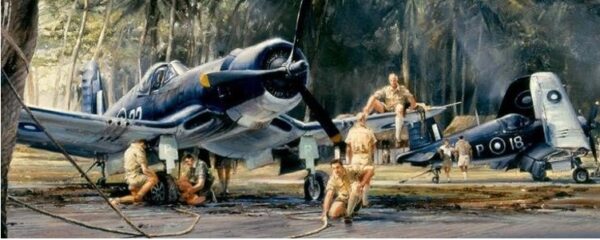
Close-up detail from Robert Taylor’s painting
This is where the unique ‘heavy haulage equipment’ of HMS Rajaliya came into play. The Royal Navy at Puttalam kept several elephants on its inventory for the purpose of dragging its stick-in-the-mud Corsairs back onto firmer ground. One animal had the name ‘Fifi’ painted in large letters on her sides.
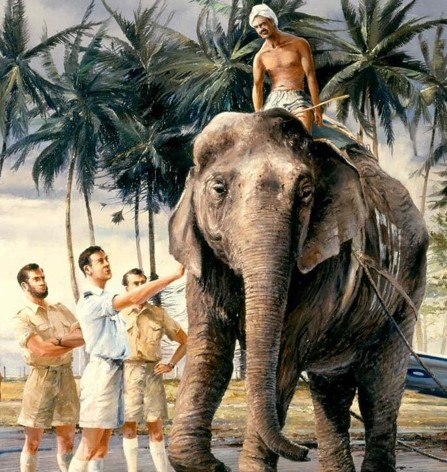
Close-up detail of the famous ‘Fifi’
Commander Sam McDonald-Hall was one of the pilots attached to the Royal Navy at Puttalam. It was he who gave Robert Taylor the idea for the painting and eventually commissioned it. To aid the artist, McDonald-Hall supplied Taylor with valuable background information about operations at HMS Rajaliya and the sterling service rendered by the ‘Puttalam Elephants’.
In a letter to Taylor, describing landing conditions at Puttalam, he wrote: “After a shower the runway (steel strips) turned to ice, you stamped on the brakes, locked the wheels, and the Corsair slid gracefully into the sand (which turned to mud after rain). Call for the duty elephant. Ropes were fixed to the jumbo’s collar, and led to the undercarriage legs of the Corsair, just above the wheels. To get the outfit back on the runway, the elephant had to pull from the opposite side, as jumbo did not like padding around on the metal tracking. The jockey (mahout) sat on the elephant’s neck, clad only in a loin cloth. The elephants also towed the petrol bowsers.”
Supplementing his notes, Commander McDonald-Hall gave Taylor a rough sketch showing the layout of Puttalam airfield and its surrounds at the time. On it he annotated such details as: “sea; camp; coast road; palm trees; sand; runway; jungle (dense)”.
A few months after the ‘Puttalam Elephants’ painting was completed and presented to the museum at Yeovilton, Taylor received a telephone call from another former Royal Navy Corsair pilot who had been stationed at Puttalam. He asked Taylor how he had known he was there, because he (the ex-pilot) had been accurately portrayed in the painting! This must surely be a tribute to the clever imagination and artistic skills of Robert Taylor.
And speaking of his skills, before Taylor began specialising as an aviation and maritime artist he spent the first six months as a professional painter drawing nothing but animals, including pictures of elephants. Few would disagree that his unerring representations of animals and aeroplanes have come together to excellent effect in this delightful vignette from wartime Ceylon.
*****
Puttalam-Palavi Post Scripts
On Saturday, June 3, 1939, four years after Ceylon’s first dedicated airfield was established at Ratmalana, the country’s first formally-designated ‘emergency landing field’ was declared open at Palavi, approximately 11km south of Puttalam town. The new airstrip was primarily intended for use, if and when necessary, by private and commercial aircraft flying between Colombo (Ratmalana) and India, especially scheduled services to Ceylon operated by the Bombay-based Tata Sons airline. But the Puttalam airfield also served as a rest and refuelling stop for pilots from the Ratmalana-based Aero Club of Ceylon during their intra-island, cross-country training flights, as well as on longer trips to/from southern India.
With the onset of World War II, recreational flying in Ceylon began winding down as most of the Aero Club’s aircraft were impressed into service with the British armed forces. Meanwhile, military airbases across the length and breadth of the island were constructed for the Royal Air Force and Royal Naval Air Service/Fleet Air Arm. One of the latter’s bases, or shore stations, was located at the Puttalam-Palavi airfield, with the official designation HMS Rajaliya.
After the war, and over the decades following Britain’s gradual, post- Independence withdrawal of its troops from Ceylon, the Puttalam base fell into disuse, more or less reverting to its status as an emergency field or transit point for leisure and training flights.
Much later, in 2000, with Sri Lanka embroiled in the Eelam War, the fabled airbase in the North Western Province was reactivated as Sri Lanka Air Force Station, Palavi to house No. 5 Air Defence Radar Squadron. But no flying operations of any significance were conducted from Palavi, except for the occasional hosting of transient SLAF helicopters or, more rarely, Y-12 light transport airplanes.
A few years after the ethnic conflict ended in May 2009, I got an opportunity to see the storied site where, nearly 70 years earlier, elephants had played their part in the conduct of warfare, albeit in a non-combative role. During a holiday in Sri Lanka in November 2012, I was privileged to visit SLAF Station, Palavi as a guest of the Acting Commanding Officer. Accompanied by my friend Capt. Gihan ‘GAF’ Fernando and our wives, I rode in an Air Force vehicle along the length of what remained of the again-disused runway.
The surface was in a deplorable state of disrepair, the few relatively intact sections of tarmac both insufficient and inadequate in length and strength, respectively, for use by even a light fixed-wing airplane. Which explained why the only ‘flying machines’ in evidence at the time were two SLAF helicopters parked in the distance.
However, ‘GAF’ and I were fascinated to see, still embedded in the rough-and- crumbling runway surface, faint imprints of the PSP/Sommerfeld Tracking dating from those long-ago days of Corsairs and elephants at HMS Rajaliya.
Further confirmation of Palavi’s peacetime existence as a non-aeronautical base were revenue-making enterprises being undertaken by the SLAF. For example, construction of modest two-storey apartment buildings for use by SLAF personnel and their families as holiday accommodation; and the manufacture of yoghurt to commercial standards of preparation and packaging, using milk sourced from local cattle-owners.
Rounding off our visit, during a superb rice-and-curry lunch in the private dining room at the Officers’ Mess – followed by delicious, ‘home-made’ SLAF-branded yoghurt with kitul treacle for dessert – an officer proudly showed us the sole office copy of a spiral-bound folio of photos, articles and other material about HMS Rajaliya and the ‘Puttalam Elephants’. Taking pride of place were a scanned image of Robert Taylor’s painting, and my related Sunday Times articles.
*****
Prints of Robert Taylor’s ‘Puttalam Elephants’ picture are available at the following outlet:
https://www.aces-high.com/catalogue/view/puttalam-elephants
*****
https://hyperscale.com/2007/features/puttalamelephantsmt_1.htm
Above is a link to an article, from the HyperScale website, by aircraft modelling enthusiast Mike Thompson, describing and illustrating how he created this wonderful diorama in 1:48 scale of an ‘action scene’ inspired by Robert Taylor’s ‘Puttalam Elephants’ artwork. A view of Thompson’s masterpiece is shown below.
